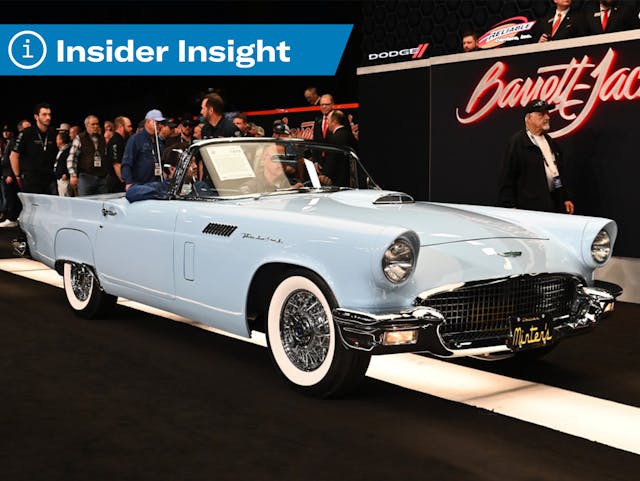Media | Articles
The January auctions, in four charts

Want a better understanding of what’s driving collector-car values? Sign up for the Hagerty Insider newsletter.
January 2023 is over, but it lives on in the Hagerty valuation team’s spreadsheets. Something like 6400 vehicles crossed auction blocks in Kissimmee, Florida, and Scottsdale, Arizona—a huge dataset that gives us a sense of how the market is performing. We’ll be diving into specific sales in the days and weeks to come, but here are key takeaways.
Another world-record January, this one driven by Mecum’s growth
Let’s not bury the lede: Despite all the talk about a cooling market, January was bigger than ever, with nearly $500M in sales. That’s the second straight year of record sales, which is quite remarkable when you remember that two years ago at this time (early 2021), people were wondering if the big in-person sales would ever return to their previous heights.
Zoom in, and you get a sense of how the in-person auction scene has changed. Back in 2008, Barrett-Jackson held the lion’s share of January’s $170M+ sales. That tiny yellow streak from the same time period represents Mecum Auctions’ upstart event in Kissimmee, Florida. Today, that small Kissimmee auction has leveraged the pandemic boom to become a towering event—$224M from the sales of some 4000 vehicles. Not to be outdone, Arizona auction week finished with $263M in sales, although that was from all auction companies.
https://datawrapper.dwcdn.net/bpUgH/3/
Marketplace
Buy and sell classics with confidence
There were big winners … but also some serious losers
Buying and reselling quickly—”flipping“—is always a risky game. Add to that game the volatility of pandemic-era appreciation and the inherent weirdness of a multi-day big-tent auction—where you never know exactly who is in the room when—and the risks only grow.
The chart below shows the top five gains and losses for vehicles sold this January that were bought at auction since 2019. Many of the biggest losses (and there were a lot of losses) came from vehicles bought since August 2020, the approximate start of the pandemic collector car boom, but surprisingly, two of the biggest gains also came from cars that were purchased at the height of the market. A 1957 Ford Thunderbird sold for $495K after being bought for $71,500 only ten months ago. A 1962 Chevrolet Corvette with 9000 miles sold for $572,000 after being bought for $160,000 on Bring a Trailer 5 months prior. If you’re willing to play, you need to be prepared for anything to happen.
Profits trumped loses, but that doesn’t mean everyone went home happy
That said, the huge price gains during the pandemic have not suddenly slipped away. Not by a long shot. Looking at all the repeat sales we tracked, the average time between a car being bought and then sold at the January auctions was 4.3 years. Most of those cars won, and some won big. For instance, a Lamborghini Miura bought for $990K in 2011 sold at RM Sotheby’s Arizona for $3.58M. Sales like these helped cumulatively benefit sellers to the tune of $17.69M gained. That said, there were also $6.02M in losses. Imagine buying a car for $1.5M in 2016 and selling it for $500K at Barrett-Jackson’s auction this year.
Average sale price at Barrett-Jackson mirrored 2022
The average sale price at Arizona this year came in at $117,534, just $5K under 2022’s average of $122,733. That’s pretty close when you consider the sheer amount of metal Barrett-Jackson moves, and at no-reserve to boot. Given that inherent volatility, it’s amazing to see how consistently prices creep up over the week from one year to another (see chart below). B-J has made a science out of sprinkling just enough high-interest cars early in the week to maintain energy, while keeping its powder dry for the final Saturday afternoon and evening.
Check out the Hagerty Media homepage so you don’t miss a single story, or better yet, bookmark it.

